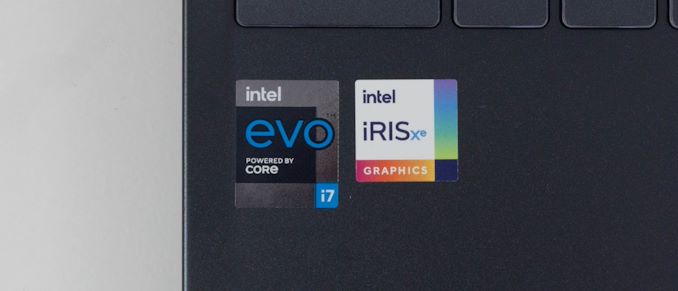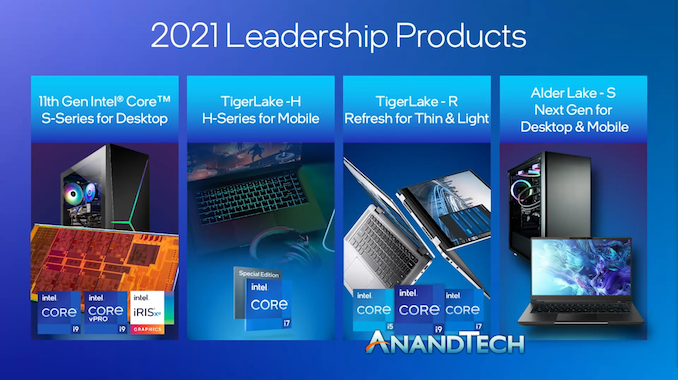Intel Confirms Tiger Lake-U Refresh Later in 2021
by Dr. Ian Cutress on April 27, 2021 10:00 AM EST- Posted in
- CPUs
- Intel
- Notebooks
- Tiger Lake
- Xe-LP
- Willow Cove
- 11th Gen
- Tiger Lake-U

The combination of Intel’s ability to drive 10nm product onto the shelves coupled with silicon supply chain shortages has put into question exactly what might be coming into the market later this year on the client side of the business. A few weeks ago Intel stated that across the company five CPU platforms would be coming to market in 2021: Rocket Lake, Jasper Lake, Ice Lake Xeon, Alder Lake, and the Tiger Lake-H series of processors. Tiger Lake-H at 45W+ will come to market in Q2, however AnandTech has learned and confirmed that later in 2021 Intel will also be launching a refresh of its notebook 15-28W Tiger Lake-U processors as well, called TGL-R.
The original Tiger Lake-U family was launched in September 2020 using Intel’s 10nm SuperFin manufacturing process. The silicon design used four of Intel’s latest Willow Cove processor cores, with the top 28 W model offering a turbo frequency up to 4.8 GHz and a base frequency of 3.0 GHz. Tiger Lake also enables 96 execution units of the new Xe-LP graphics technology, up to 1350 MHz, with support for DDR4-3200 and LPDDR4X-4266.
Technically Intel stated that Tiger Lake-U also supported LPDDR5-5400 when the product was launched, however we have not seen a Tiger Lake-U design with this feature. A Tiger Lake-Refresh might have this key feature enabled with a new family of processors, alongside minor frequency increases as Intel is able to optimize its 10nm SuperFin manufacturing process.
During Intel’s presentation where TGL-U refresh was mentioned, it was specified that the refresh will only apply for 15-28 W processors. Earlier this year Intel launched TGL-H35, which is a misleading name as it uses the U-series processors but brings them up to 35 W (the name suggests a 45W H-series processor reduced in power, but it isn’t). Going on what was presented, these 35W versions of the U-series silicon will not get an equivalent refresh, at least based on this slide talking specifically about 2021.
There are two ways to think about Intel launching TGL-R.
First is that Intel has already announced that its next-generation Alder Lake processors, using a Core + Atom hybrid design, will be coming out later this year for mobile and desktop. That platform would seem to benefit heavily from having the high-efficiency Atom cores in notebook designs more than a TGL refresh. It would seem odd for Intel to offer a Tiger Lake-U refresh if Alder Lake was close to being ready; and so one might conclude that the mobile versions of Alder Lake are more of a late Q4 discussion.
The second is the LPDDR5 angle, assuming that is working. Intel may now have validated the silicon for LPDDR5-5600 which might not have been possible when TGL-U was launched, or LPDDR5 availability may now be at a level that Intel’s OEM partners can deploy it at a reasonable cost. A fully populated LPDDR5-5600 mobile processor would enable a peak memory bandwidth of 89.6 GB/s, which is 75% above DDR4-3200 or 31% above LPDDR4X-4267. For graphics workloads, this would surely boost performance.
If Intel doesn't have LPDDR5 systems with TGL-R, then we fully expect the new line of processors to solely have frequency updates.
Related Reading
- Intel’s Tiger Lake 11th Gen Core i7-1185G7 Review and Deep Dive: Baskin’ for the Exotic
- Insights into DDR5 Sub-timings and Latencies
- Intel Announces Phantom Canyon: Tiger Lake and Turing Tango in 3rd Gen Enthusiast NUC
- Intel at CES 2021: Ice, Tiger, Rocket, Jasper, and Alder Lake
- Intel’s New H35 Series: Quad Core Tiger Lake now at 35 W for 5.0 GHz
- The MSI Prestige 14 Evo Review: Testing The Waters Of Tiger Lake
- Intel’s New NUC Laptop Kit: Whitebook Tiger Lake For All
- GIGABYTE Unveils BRIX PRO Mini-PCs with Tiger Lake-U











36 Comments
View All Comments
Otritus - Tuesday, April 27, 2021 - link
If Intel were to have a saving grace in 2021 it would potentially be Alder Lake. That Alder Lake is being pushed aside in favor of Tiger Lake doesn't bode well for Intel. It is possible 10 ESF capacity is limited, and Intel is prioritizing dies for high-end mobile and desktop-s, but only time will tell.eek2121 - Tuesday, April 27, 2021 - link
Man, give it a rest. Tiger Lake is competitive with Zen 3. The only shortcoming is that they don’t have 8-core U chips. The 11800H thus far looks to be faster than the Ryzen 5900HX.goatfajitas - Tuesday, April 27, 2021 - link
"Tiger Lake is competitive with Zen 3"- Until you factor in heat and power.
teamet - Thursday, May 6, 2021 - link
I'm running a AMD 4650U Pro, 6 cores, and the needed cooling is obcene.. I wish I'd opted for an intelgagegfg - Friday, May 7, 2021 - link
Surely the cooling system of your notebook is of poor quality. It is priced by AMD to enter the market with assemblers to offer low prices. ALREADY with Rysen 5000 that changed for the most part.yankeeDDL - Tuesday, April 27, 2021 - link
Intel's power consumption has been proven (also here at AnandTech) to be vastly underreported. A 45W 11800H is slightly faster than Ryzen 5800H (in Geekbench only) but it likely consumes twice as much (I could not find any actual data on real power consumption) and it is slower than the 5900H.I'm with Otritus here.
goatfajitas - Tuesday, April 27, 2021 - link
Exactly. Its past the point of deceptive on Intels part.drothgery - Wednesday, April 28, 2021 - link
Since the real Tiger Lake H hasn't been released yet (the current "H" models are just Tiger Lake U with a higher TDP), any data is from leaked testing on engineering samples, not real production parts.Spunjji - Wednesday, April 28, 2021 - link
Competitive, for sure - but that has nothing to do with the post you're replying to 🤔Santoval - Saturday, May 1, 2021 - link
"Tiger Lake is competitive with Zen 3." Only its iGPU is, and only at its (scarce and expensive) fattest configurations. That's because AMD got cocky and thought their APUs could still take on Intel's brand new Xe iGPUs with an ancient iGPU from 2017. A fat (64+ EU) Xe iGPU can surpass in performance an equivalent Vega iGPU just like it was expected. If even Xe couldn't beat Vega Intel would be in even deeper trouble..